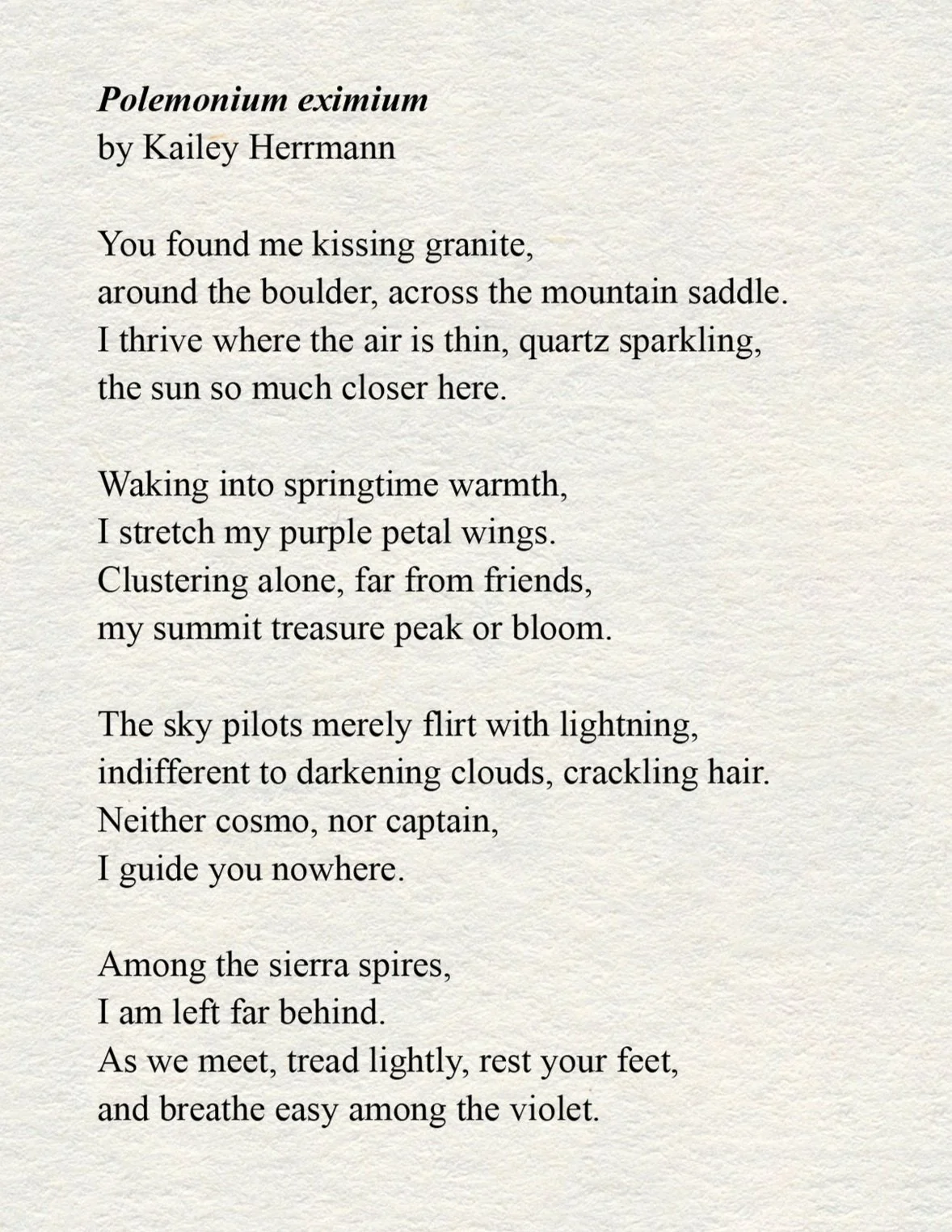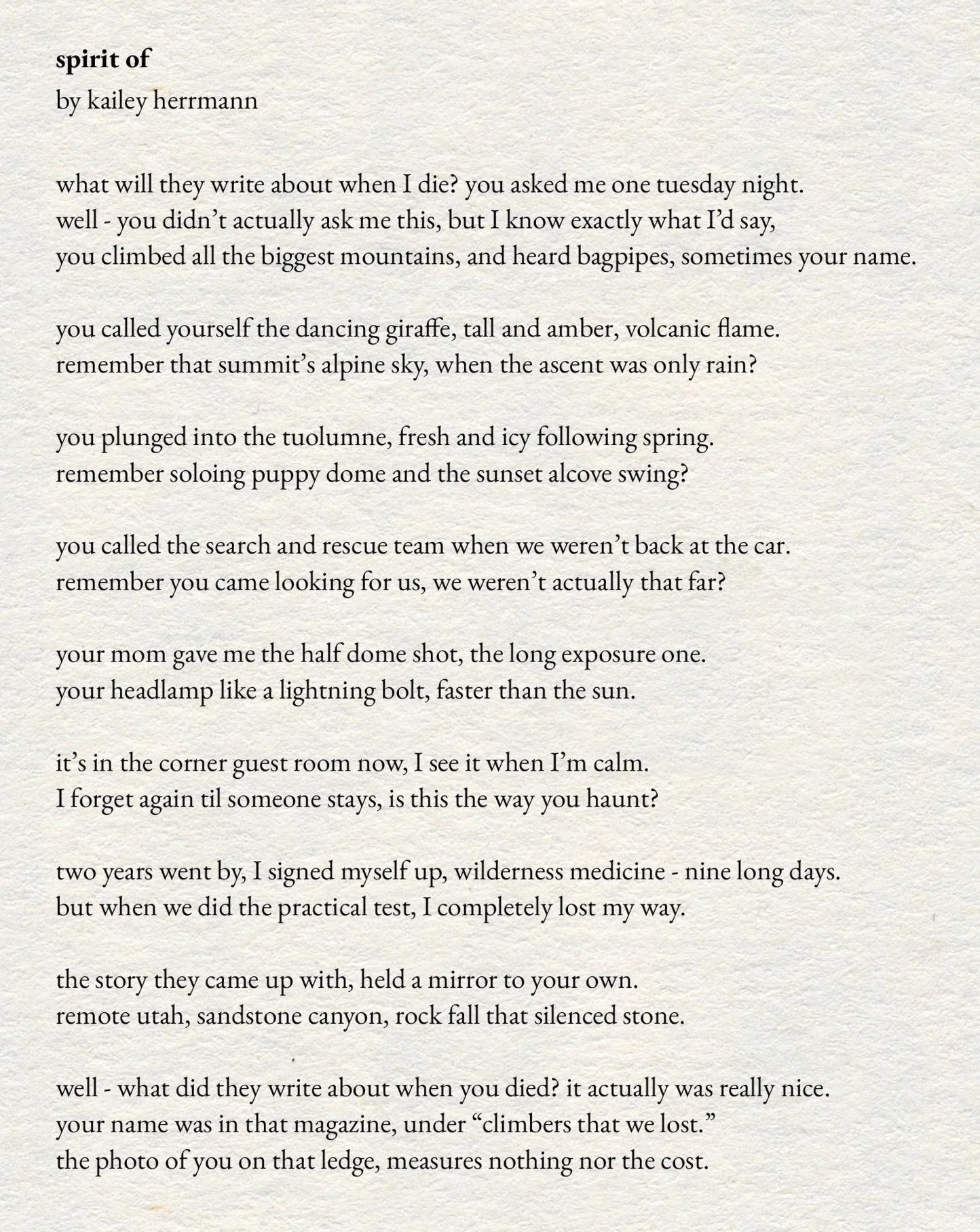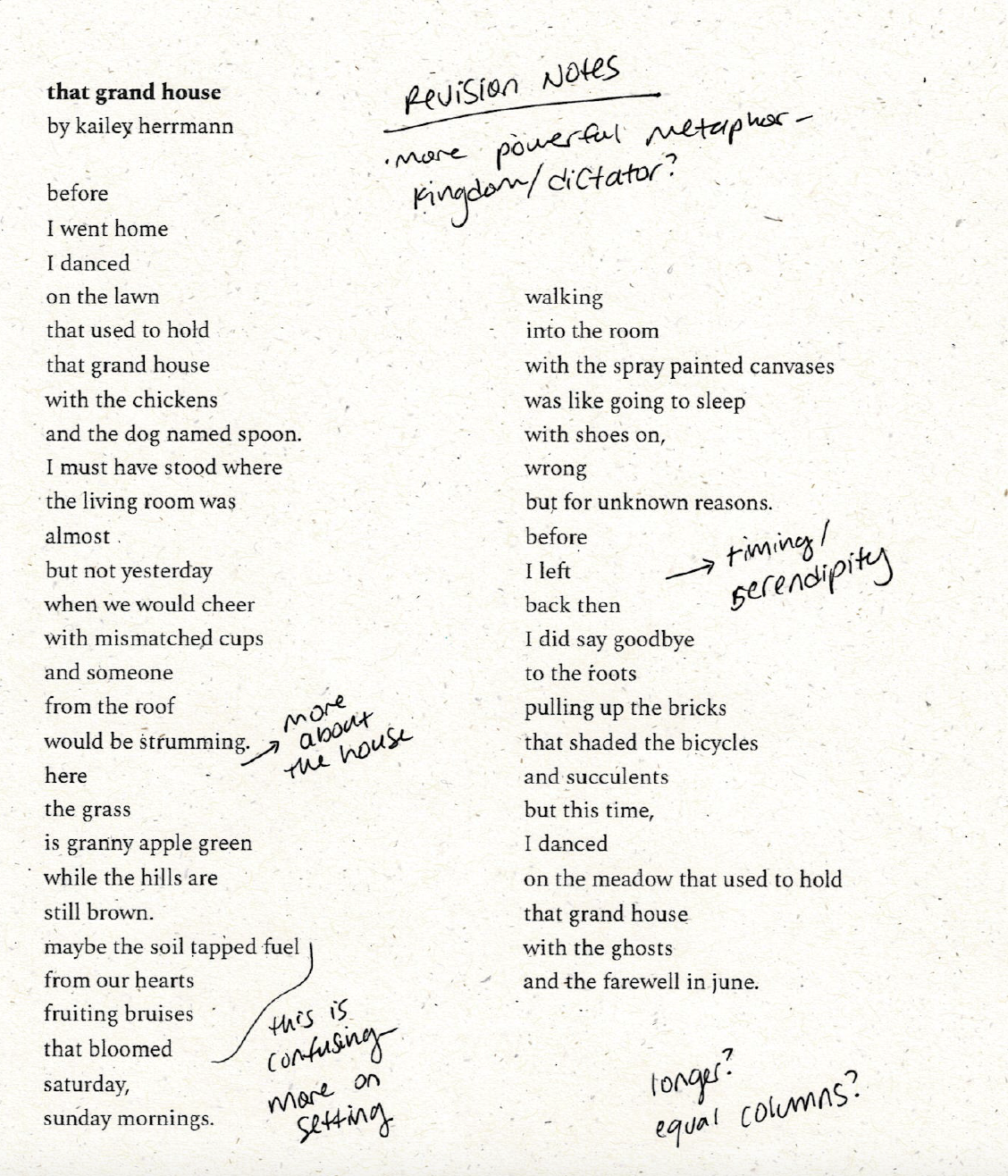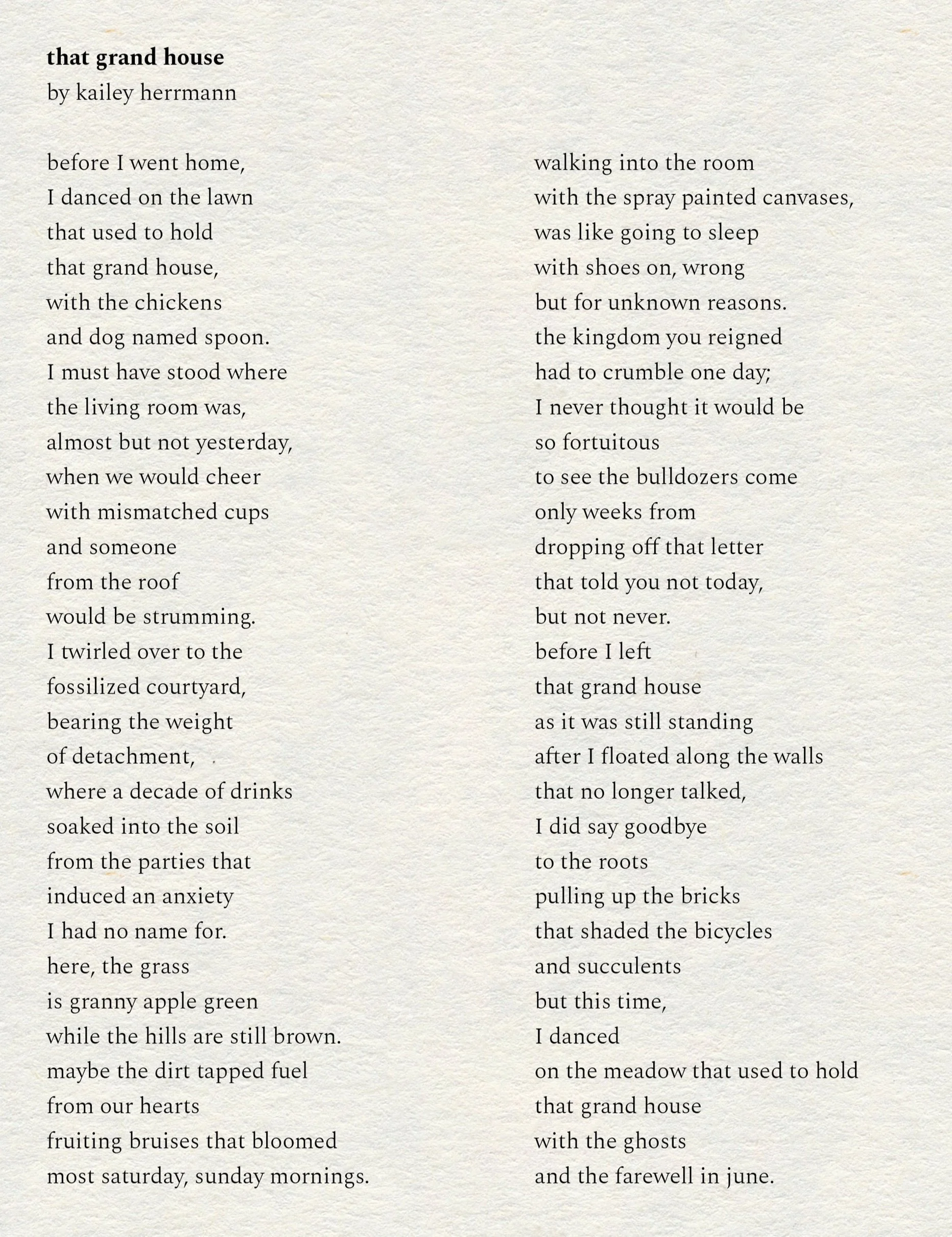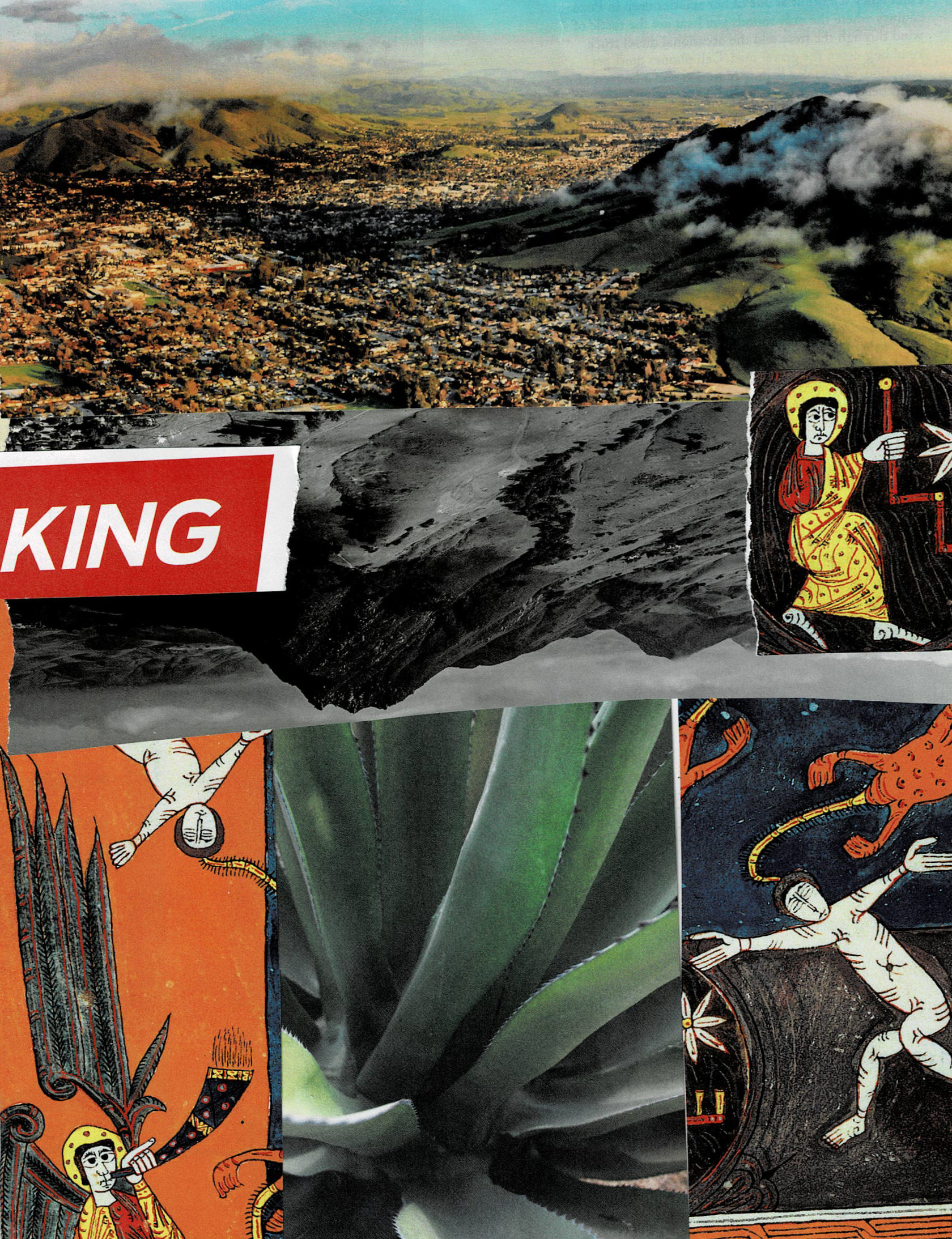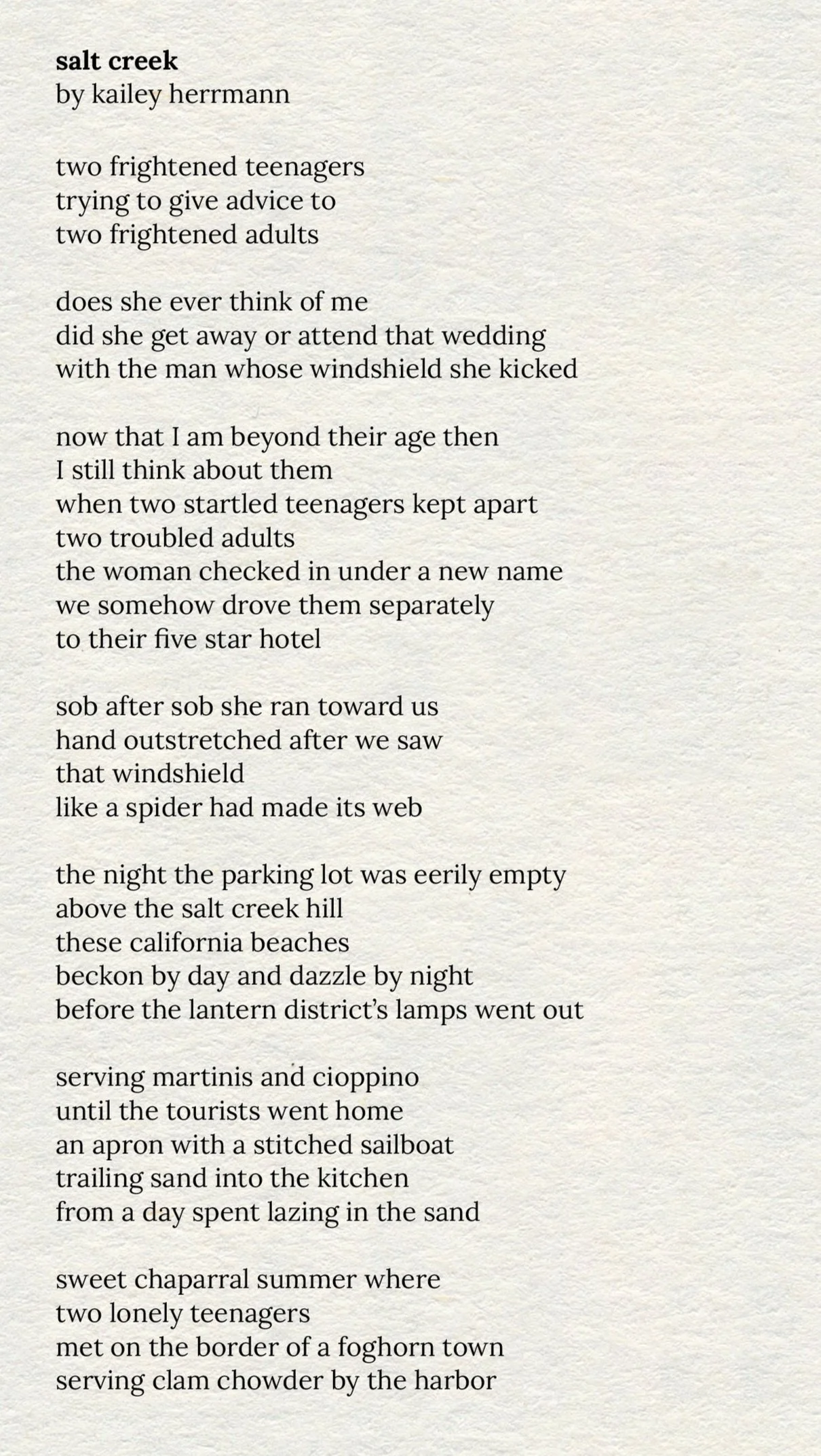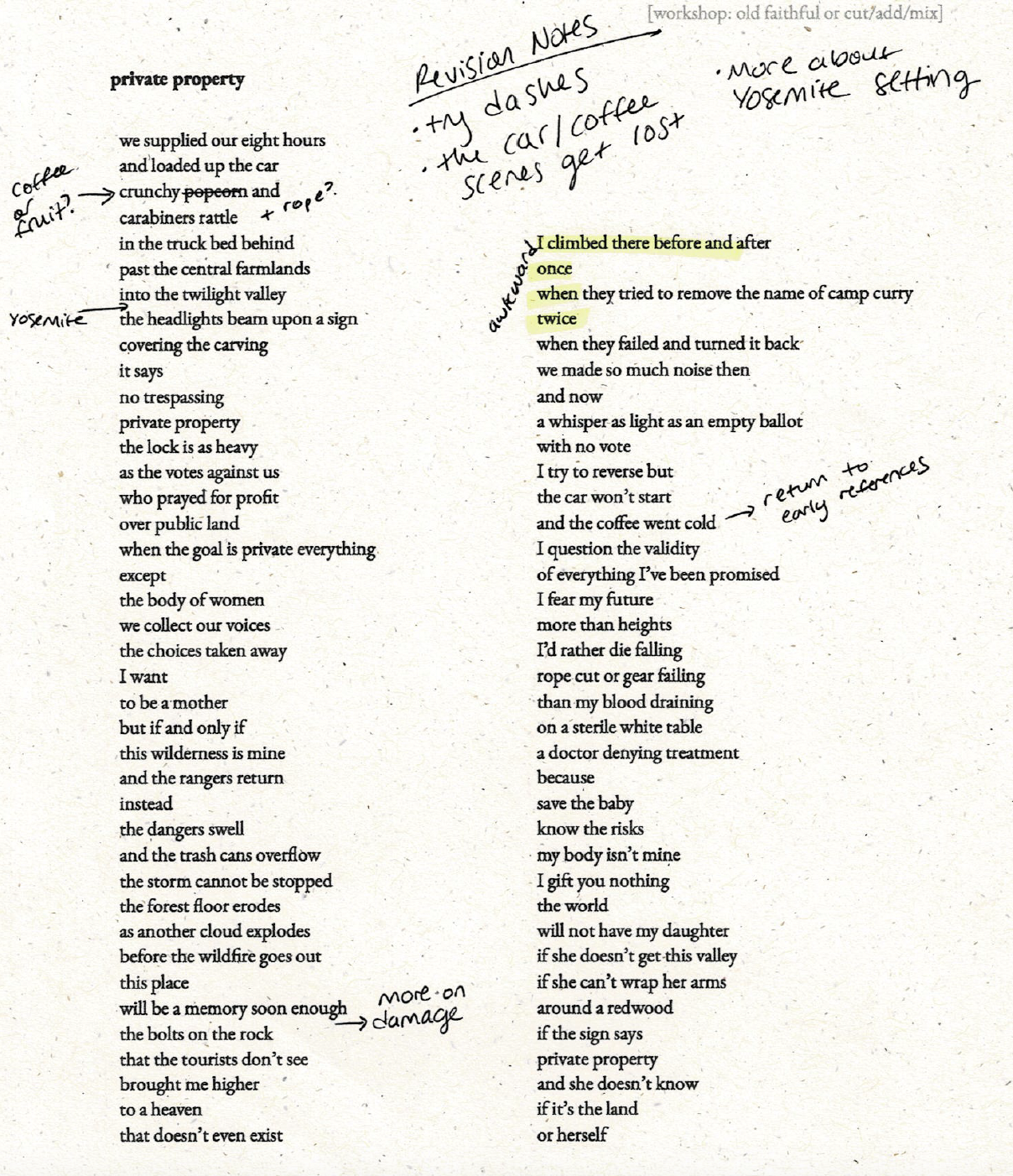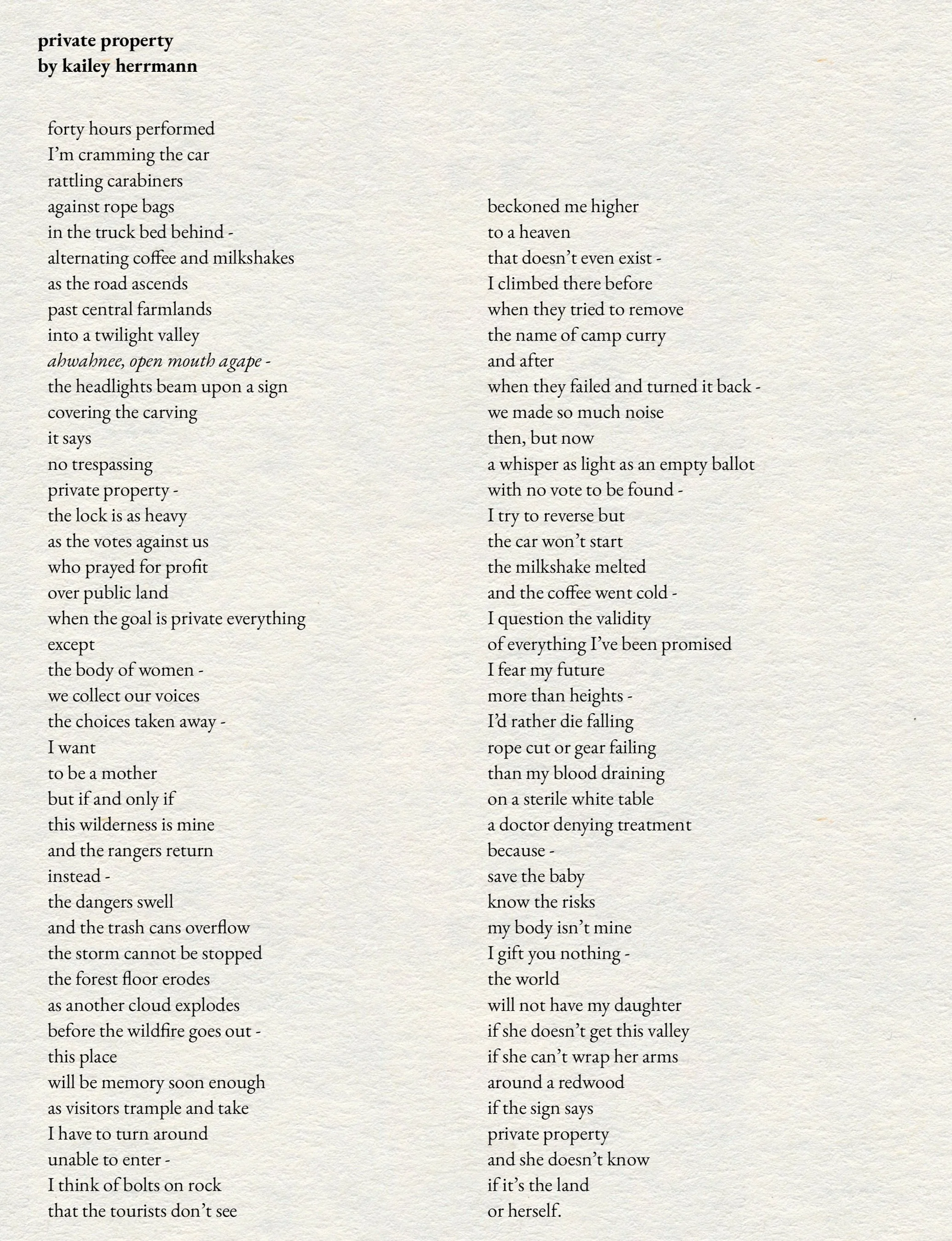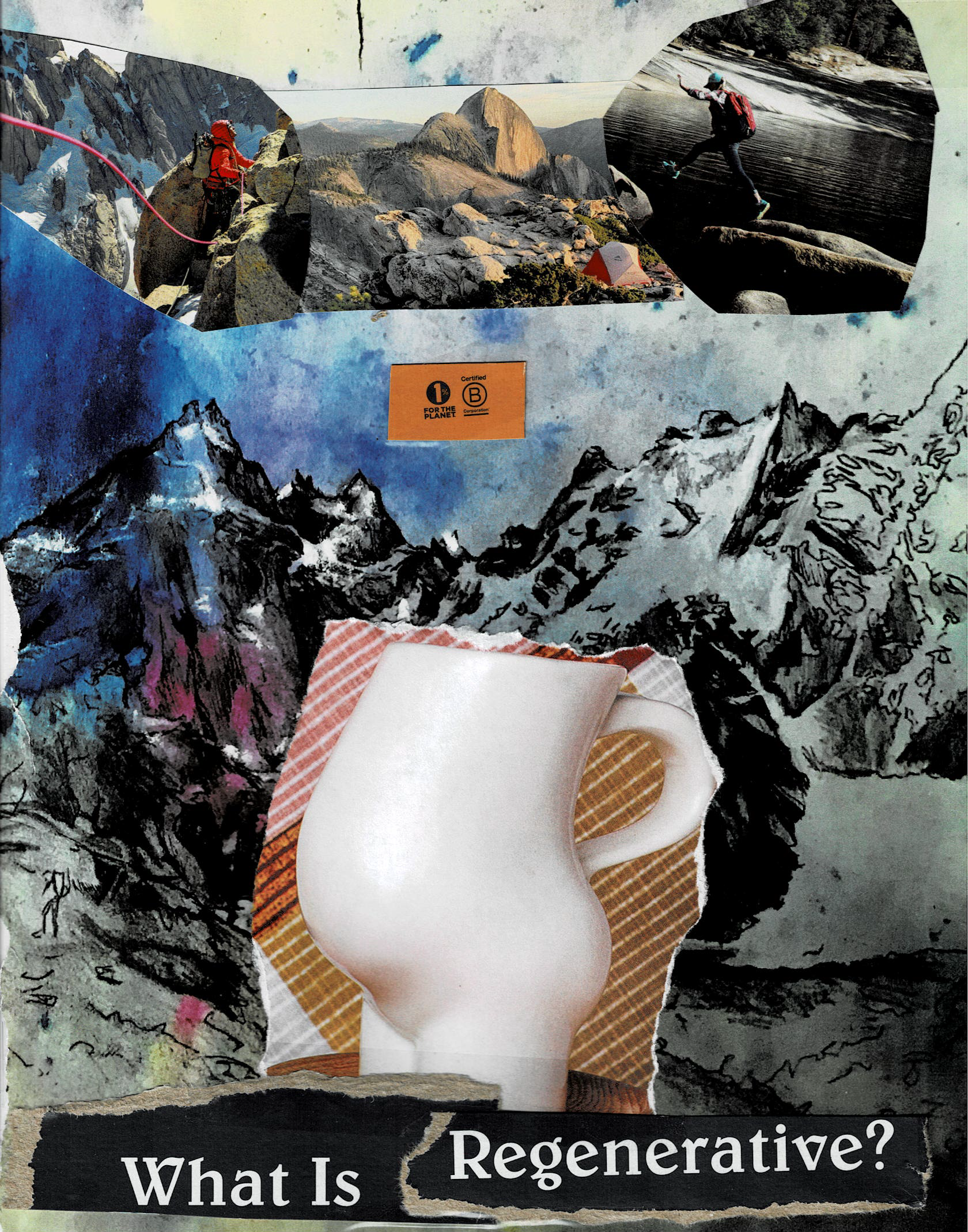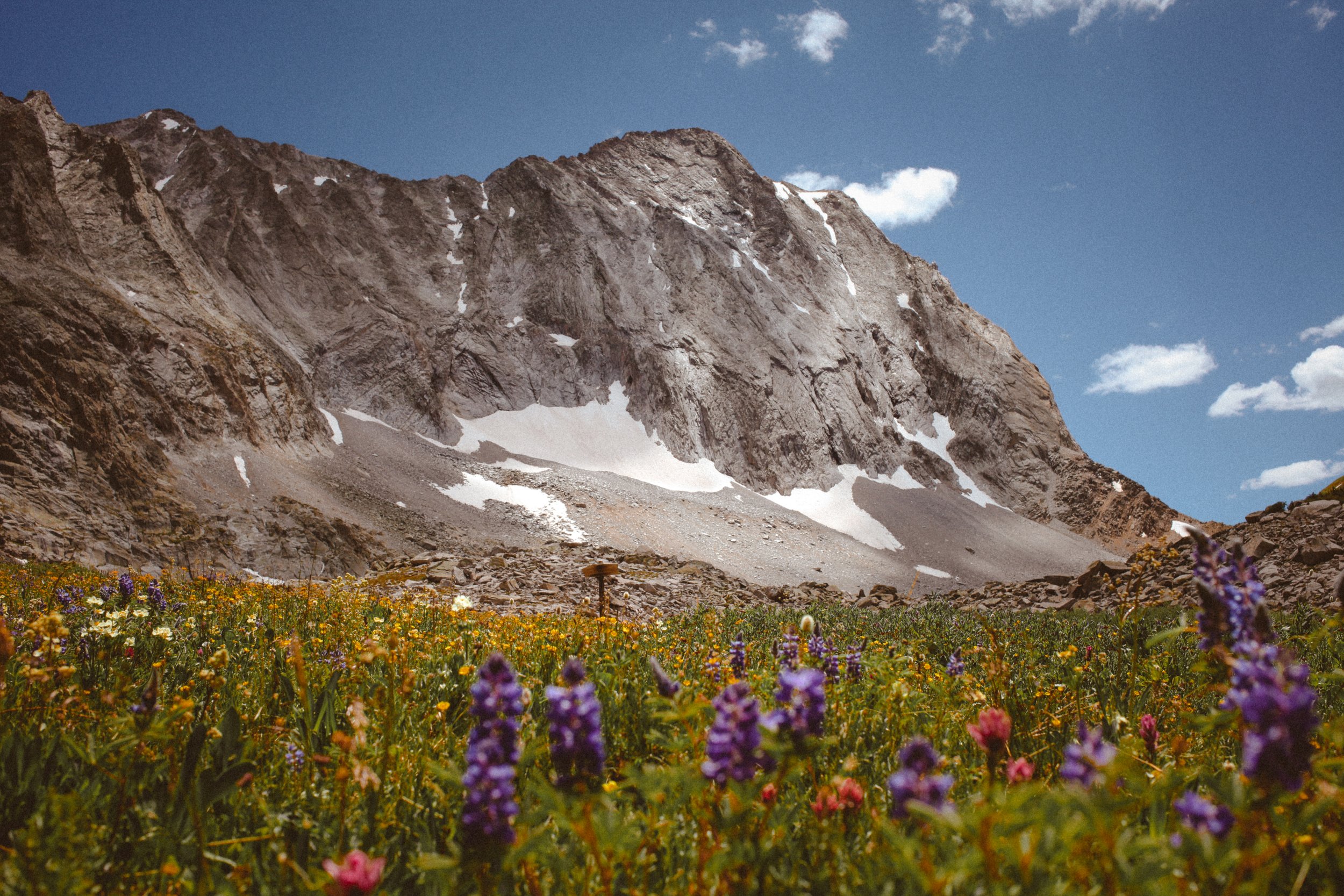
ENGLISH 488
Advanced Poetry Workshop
Final Portfolio
by Kailey Herrmann
Artist’s Statement
Do you know what swirls around in my head the most? Words. From being a little kid, staying up way past my bedtime to read books by moonlight, to studying literature as a graduate student, I have always been drawn to words. There are just so many words. Poetry itself was a beautiful mystery to me up until this year. I had dabbled in reading the greats, studied a bit of the Romantics, but it was finally my turn. I let all those swirling words inside my brain drip out one by one, and they are still flowing in droves. I didn’t expect the act of writing poetry to be so intoxicating. Why I never let myself write poetry before this class, I’ll never know. Now that the floodgates have been opened, I am quite insatiable. I promise I’m not exaggerating. When I begin a poem, I tug on whatever string of emotion is affecting me most. Maybe it’s a memory, heavy with nostalgia, or some innate fear for the future. The settings of my poems usually end up materializing out of my experiences in the outdoors, when I either felt those feelings in full force, or was able to let them go and get in the zone. I often end up in the mountains, on a peak somewhere in the Sierras, in the desert of Joshua Tree, or along a river in Big Sur. I hope to transport my readers to these places as best I can - to bring the smells of the flowers, the soft touch of the breeze, the sharpness of the granite to their fingertips. Not only do I want my readers to feel present there, but to be given a taste of the feelings that can be felt in those places. I hope to bring complexity to outdoor experiences, where one can be thinking of climate change, motherhood, loss, life, love, fear, what they ate for breakfast, what art means to them, all at once. Humanity is not that simple. I love when it all comes crashing together in a salty, sunny, muddy, tangled mess.
My poetry has evolved, I admit, in the way I expected it to. The words I’ve held onto in my head for so long, it made sense they would tumble out in the free flowing way. When I began writing for this course, simply rhymes felt familiar, but not necessarily comfortable. I started there, but discovered very quickly it did not feel like my own voice. I wanted to find that rhythm that sounded so melodious when other students read their poems aloud in class. This led to softening my approach with less rules on rhyme or structure or lineation. I played with enjambment, lower case sentences, less punctuation, and slant rhymes. Poetry became fun - a game I got to make up the rules for, and continue to break them, and still “win.” I think of winning the game of poetry as merely a personal satisfaction with the piece - to be able to close the notebook, sigh, and think, “I’m happy with that.” The more unexpected aspect of my poetry evolution was the emotion. I thought I’d spend more time writing about wild outdoor places, my rock climbing experiences, the flowers I love finding. I ended up weaving heavy anecdotes within those poems - experiences of loss, memory, identity, and change. I tried not to be embarrassed when tears fell in globs after I read “spirit of” in front of the class. Writing the poem itself was a cathartic exercise; reading it aloud to who were essentially strangers was entirely different. It made the poem real and living then, and that was the moment that I felt like I became a poet.
I’m most proud of the poems I wrote later in the quarter, as my voice had found a cadence I was quite happy with. Sonic texture became a mild obsession, and I’d sit at my desk writing poems for the next week’s module, whispering collections of words to myself and seeing how the felt in my ears. From this class, my favorite of my poems is “private property.” I spent the most time on it out of any other piece, and I felt myself pouring out over it. My anxieties over motherhood, the dismantling of our national parks and public lands, and my subtle guilt over my departure from climbing, all amassed into this one poem. I was immensely proud of how it turned out, and even more so upon my multiple revisions. This poem felt like me. It didn’t necessarily feel like a protest poem, but it still felt powerful; I wanted to communicate that a single person can feel these things - fear, empowerment, strength, anger, pressure, regret, shame, and bravery - all at once. Some emotions we may not even have words for, and I hope my poetry communicates the complexity of that. Sometimes nature has to speak for us. Or it acts as a vehicle for us to communicate something unrelated. Similar to Geoffrey Brock’s poem, “Parable,” I enjoy the challenge of writing about outdoor activities that everyone may not be able to relate to, but connect it to other emotions and experiences, such as emerging from a dark, wet winter and finally getting outside, or the prize of an ice cream cone. It can be difficult to discuss something that has a technical component - like cycling - and not make it seem robotic or dull. The other collection we read, Best Barbarian by Roger Reeves, was a bit more difficult but still plenty inspiring. The poem I remember the most was one that we critiqued in class - “The Alphabet, for Naima.” Although the execution felt a bit off, as we had discussed (especially the alphabet ending before “s”), I enjoyed the mix of playfulness and seriousness in the poem. I was motivated to try a similar mix of tone in my poems. I did try out writing an abecedarian poem, and although I have not finished it, it was a unique exercise to try to emulate.
During the weeks with our Working Anthologies, I found myself drawn to reading poems that were written in styles I had no plan to reproduce, but I could use as inspiration anyway. One of my favorites was when Sydney read “Advice to the Able-Bodied Poet Entering the Disability Poetics Workshop” by Liv Mammone. The list poem style is not a style that I enjoy writing in - right now, anyway - but it provided a distinct inspiration that allowed me to view the world from a different perspective. I think I enjoy reading poems that don’t reflect my own style or voice because I know I won’t try to mimic them. Same goes for solid rhyming poems, which I’ve decided is not the style for me. Back during week 5, Allie shared a Robert Frost poem, “Nothing Gold Can Stay.” It’s a beautifully simple poem, with neat rhymes: gold/hold, flower/hour, leaf/grief, day/stay. It’s lovely, and I get a warm feeling when I read it, and although I know I won’t try to echo the style in my own writing, it still inspires me to explore rhythm and themes of color and nature.
In ten short weeks, I somehow became a poet. The biggest step was putting those swirling words down on paper, and the revising steps felt almost as large. I’ve unlocked a new superpower, a new way of communicating with the world, and for that, I am grateful. I thank the universe that I now have an endless supply of poetry to read and glean inspiration from, and I hope my pen never runs out of ink, and my brain never stops filling with words that I can continue placing on a page.

Revised Poems
This section includes the following for each revised poem:
Workshop drafts (“before”) with annotations on revision experiments and notes
Final drafts (“after”)
Creative process accompaniments in the form of multi-media collage (for poems 1-4 and 6)
Post-write reflections
Poem #1
Before
After
Collage
Reflection
It shouldn’t come as a massive surprise that my first poem is my least favorite, looking back. I was still trying to find my voice and I can’t help but cringe a little at how it sounds. I had a feeling I could break it down completely, but it would change the entire poem; for some reason, that didn’t feel right. Initially, I thought I’d pull from one of the non-rhyming words from the existing stanzas and try to rhyme with them in the new tercets, but that proved to be too difficult and it sounded strange. I ultimately decided to just do a playful revision experiment where I would add an entirely new poem in between each stanza, instead of rewriting it. I continued the rhyming by adding couplets and went with a theme of “see/hear/speak,” inspired by the “see no evil, hear no evil, speak no evil” proverb of the three monkeys. I was mildly inspired by the TV show, The White Lotus, which plays off of this concept with highly privileged characters on a luxury vacation. Many of them are manipulative dysfunctional, and only care about themselves. The show always includes a murder mystery, and I wanted to shift the tone of the poem toward those themes of evil games and divine judgment. Even though I was unhappy with the original poem, I like how it turned out with the experiment! I hope it mixes playfulness, evil, death, discomfort, anxiety, and hope.
Poem #2
Before
After
Collage
Reflection
I remember from workshopping this poem, some of the comments showed confusion about some aspects of the poem, especially in terms of the sky pilot flowers and the existence of lightning. I think this poem was initially too vague, and while I like writing with a more “show, not tell” style, it went a little too far. My notes indicate the things I want to expand upon and explain better. As far as a revision experiment, I thought it would be enjoyable to change the perspective from the “I” speaker to be from the point of view of the flowers themselves. What would they say to the hikers and climbers that come upon these rare flowers? I love anthropomorphizing plants, and it was fun to imagine what these flowers would experience as they bloom for the first time and greet their surroundings. There were a few words and phrases I really wanted to keep, so I highlighted those in yellow. I personally see this revision experiment as a success! The poem seems to flow better, with a comforting and friendly tone that I quite like. The new revision did lose the question aspect of the original (“tell me/what are you/hide for me”) that I initially liked; maybe I can turn that into a new poem about different flowers or plants another day.
Poem #3
Before
After
Collage
Reflection
I knew this would be a difficult poem to revise. Not that I think it’s perfect, but because of the subject matter being so heavy and close to my heart, I wanted to be gentle with the poem and with myself on the approach. I decided to focus on more technical aspects of it, such as lineation and enjambment. This was one of the first poems that I played with more enjambment than I had before, and I definitely prefer it, but I started to wonder if this poem needed it to be more extreme or not. I also recalled, during the workshop, some comments about the lack of stanza breaks or separate sections, and I figured that could be something to try as well. Lastly, I remembered Dr. Rosenthal’s mention of the ending - that it didn’t feel necessary. I agreed and considered that it ended too neatly about missing the person, but that wasn’t really something I wanted to say. After working on these components, I’m really happy with the revised version. The longer lines look great, I like the tercets at the beginning and end with couplets in the middle (visually, for some reason), and I’m happier with the ending. If I were to continue revising, I think I’d work more on the ending - I’m not fully satisfied - but I’m content with where the poem ended up here. It captures my feelings in a more succinct way, and highlights the rhymes and slant rhymes at the end of each line without feeling too cheesy or overdone.
Poem #4
Before
After
Collage
Reflection
I was looking forward to revising this poem the most! It felt like it had the most room for expansion and evolution - note that I did not use the word improvement - and I simply felt excited to work on it. I didn’t use any cut and dry revision experiment here, but just planned to tinker with the imagery and metaphors within the poem. The experience I am pulling from is incredibly complex - removing a friend from my life that had been a core part of my community for almost a decade - which resulting in many emotions that have been difficult to communicate. The feelings are even more fresh than the one from the “spirit of” poem. I knew I had so much more to say about visualizing the house that was demolished, the memories I had there, and the anxieties I felt at not belonging and not being good enough. I also wanted to capitalize on a metaphor that I felt reflected the situation really well; the concept of a king or dictator - as this person often acted like - and how their kingdom crumbled when the house was torn down and they serendipitously moved away. I wanted the setting to be more powerful in terms of the contrast between what the house used to be and what it is now (a grassy field). The result ended up not being as different as I expected because I kept quite a few lines that I liked and didn’t want to change. I like the new additions, especially the references to the walls that no longer talked and the bulldozers coming. I do still see this as my most outwardly confusing poem (I can only imagine most readers have no idea what is going on here) and if I were to revisit it in the future, I’d work on making the experience a touch more clear without “giving away” too much. Overall, I am happy with this revised version!
Poem #5
Before
After
Reflection
This was a poem that was rushed and I knew needs the most work. I had submitted it during a week I knew I would not be workshopped, so it would be harder to get feedback (the Canvas comments are still great! just not the same). Another nostalgic poem with a vague setting, I had to do something fun with the revision experiment so the changes wouldn’t feel like a chore. I had success with the “spirit of” poem separating the lines into sections, so I added that to the mix. The main revision experiment was to try it backwards! This felt like a silly way to turn the poem on its head and see what could happen. I knew I’d have to fudge the rules a little - not literally only go backwards line by line - but focus on each set of lines as specific sections and go backwards from a narrative sense. I tried to start by bracketing obvious sections to help me as I went. This revision was a blast! I tweaked wording and omitted phrases as I went to ensure the poem still made sense working back bottom to top. I didn’t end up changing too much, and the result was great. The poem is still incredibly confusing and vague, but I admit I kind of like that. I think the audience for this poem is myself, reminiscing about experiences of my last summer before college. If I had had an opportunity to workshop this in class, I would have picked the Oprah method so I could answer questions about the setting. It was an intense moment - my boyfriend at the time and I were walking through a beach parking lot at nighttime, and we came upon a couple, probably in their late 20s, in a heated argument. The woman came running over to us for help; she had kicked the windshield of the man’s truck before coming over to us. We were so young - 17 or 18 - yet somehow we calmed them both down and convinced them to allow us to drive them separately back to their hotel. The hotel decided to check the woman in under an alias in case the man became more angry and tried to hurt her that night. I’ll never forget that experience and I still think about her sometimes, hoping she left him. It felt good to put it down on paper, and continue to work with it into a better poem.
Poem #6
Before
After
Collage
Reflection
Even before I began this portfolio in earnest, I had already revised it a few times, despite it being my most recent poem. I reflect on this more deeply in my artist’s statement, but this is the poem I am most proud of but also most open to revising. I was so eager to make it better and better each time, and I just wanted to sit with this poem for a long time. This revision did not have a specific experiment, but focused on the notes I took during the in-class workshop. The aspects I received feedback for were the crunchy popcorn references, the lack of punctuation, and coffee mention, and the setting itself. I also went through the poem and identified which sections merely sounded awkward or off, as well as where I could expand upon the imagery. This poem was supposed to be placed in Yosemite, and I found that to not be clear enough. I also wanted to honor the land the park is on, which resulting in the mentioning of “ahwahnee.” I added in dashes where it made sense to have a slight pause, and I’m generally happy with how that turned out. I adjusted some of the awkward syntax moments - like “climbed there before and after / once / … / twice.” As much as I liked the idea of this initially, the execution just didn’t work. “Before / after” felt a lot better to focus on than “once / twice.” I took out the popcorn mention - it wasn’t important anyway - and focused on coffee and milkshakes, which I felt made the reconnection later more powerful about the milkshake melting and the coffee going cold - a much sharper contrast that reflects feelings toward the previous government administration and the current one. I’m pleased with this revision!
Writing Process Reflection
Cutting up magazines, arranging them on a piece of paper, gluing or taping the images down, and creating an entirely new piece of art in the form of collage connects me to my childhood. I was thrilled to explore collage making to complement the poetic writing process and revision experiments. I loved the idea of having to use found images and multimedia - photographs, artwork, stationery, stickers, receipts, pressed flowers - to represent not only the imagery in my poems, but also the emotions I am trying to evoke. The collage making itself allowed me to consider the tone of my poems - do my words connect with the images I’ve selected? How does the tone of the collage mirror the tone of the poem? I began with collecting magazines, mostly climbing and adventure related, rummaging through some miscellaneous paper and stationery items like to-do lists and receipts, sorting through sticker collections, flower seed packets, and ad pamphlets. I also had a big stack of SLO Life and Edible magazines, which I knew would have some great local landscapes to pull from. In a similar way that words are selected or discovered while writing poems, considering how they sound or what images they portray, I tried to find images for each poem to echo the same feelings of the content. Some were more difficult to than others, and I had to get creative to represent the more abstract concepts. Some of the collages were fairly simple - the “that grand house” collage only had a few images, but I liked turning the black and white photo of the San Luis Obispo skyline upside down, underneath a colorful version of the town, to represent the contrast of before and after. Other collages included multimedia elements, such as pressed flowers (from my garden!) and flower seeds taped down, or scraps from to-do lists and planners and a bandaid. Using these “found” elements from around my house, I was able to continue pulling on the nostalgia that many of the poems encounter. As I was digging into my own archives, it brought me back to the memories that led me to write these poems in the first place. While I was compiling the collage images, I did my best to consider how the poems changed over time and tried to have the collages represent both an evolution of the poem and a portrayal of the poem in its “final” form. I embraced the mess - scissors, tape and glue, paper scraps everywhere - and let it illustrate the state of my mind when I begin writing. Taping and gluing the images together felt like “cleaning up” the thoughts in my head, arranging them, and finding the best representation. What is so wonderful about collages is that there is no perfect or correct way to arrange the images. You can easily continue cutting or ripping (as I often did) to make everything fit, and adjust as you go. I loved the process of getting messy, organizing, playing, and being creative. It was a fantastic way to connect my artistic imagination with the poetic process.

